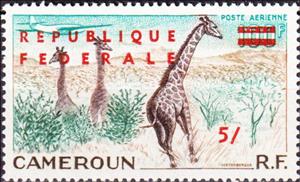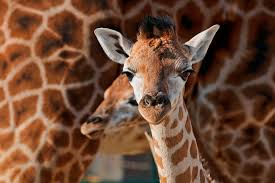Stamp: Giraffe (Giraffa camelopardalis) with British surcharge (Cameroun 1962)
Giraffe (Giraffa camelopardalis) with British surcharge (Cameroun 1962)
01 January (Cameroun ) within release Issues 1946-1960 Surcharged for West Cameroons goes into circulation Stamp Giraffe (Giraffa camelopardalis) with British surcharge face value 5 British shilling
| Stamp Giraffe (Giraffa camelopardalis) with British surcharge in catalogues | |
|---|---|
| Michel: | Mi: GB-CM 22I |
| Stamp Number: | Sn: CM C38a |
| Yvert et Tellier: | Yt: CM PA49a |
| Stanley Gibbons: | Sg: CM 295 |
Stamp is horizontal format.
Red overprint: REPUBLIQUE ═ FEDERALE 5/- Type I: New value 4*3½ mm (5/-)Also in the issue Issues 1946-1960 Surcharged for West Cameroons:
- Stamp - Douala Harbour with British surcharge face value 10;
- Stamp - Douala Harbour with British surcharge face value 10;
- Stamp - Emblem of World Refugee Year with British surcharge face value 2'6;
- Stamp - Giraffe (Giraffa camelopardalis) with British surcharge face value 5;
- Stamp - Plane over Piton d'Humsiki with British surcharge face value 1;
Stamp Giraffe (Giraffa camelopardalis) with British surcharge it reflects the thematic directions:
An aircraft (pl. aircraft) is a vehicle that is able to fly by gaining support from the air. It counters the force of gravity by using either static lift or the dynamic lift of an airfoil, or, in a few cases, direct downward thrust from its engines. Common examples of aircraft include airplanes, rotorcraft (including helicopters), airships (including blimps), gliders, paramotors, and hot air balloons.Part 1 (Definitions and Abbreviations) of Subchapter A of Chapter I of Title 14 of the U. S. Code of Federal Regulations states that aircraft "means a device that is used or intended to be used for flight in the air."
Animals are multicellular, eukaryotic organisms of the kingdom Animalia (also called Metazoa). All animals are motile, meaning they can move spontaneously and independently, at some point in their lives. Their body plan eventually becomes fixed as they develop, although some undergo a process of metamorphosis later on in their lives. All animals are heterotrophs: they must ingest other organisms or their products for sustenance.
Aviation is the practical aspect or art of aeronautics, being the design, development, production, operation and use of aircraft, especially heavier than air aircraft. The word aviation was coined by French writer and former naval officer Gabriel La Landelle in 1863, from the verb avier (synonymous flying), itself derived from the Latin word avis ("bird") and the suffix -ation.
The giraffe is a large African hoofed mammal belonging to the genus Giraffa. It is the tallest living terrestrial animal and the largest ruminant on Earth. Traditionally, giraffes have been thought of as one species, Giraffa camelopardalis, with nine subspecies. Most recently, researchers proposed dividing them into up to eight extant species due to new research into their mitochondrial and nuclear DNA, and individual species can be distinguished by their fur coat patterns. Seven other extinct species of Giraffa are known from the fossil record
Mammals are any vertebrates within the class Mammalia (/məˈmeɪli.ə/ from Latin mamma "breast"), a clade of endothermic amniotes distinguished from reptiles (including birds) by the possession of a neocortex (a region of the brain), hair, three middle ear bones and mammary glands. All female mammals nurse their young with milk, secreted from the mammary glands. Mammals include the largest animals on the planet, the great whales. The basic body type is a terrestrial quadruped, but some mammals are adapted for life at sea, in the air, in trees, underground or on two legs. The largest group of mammals, the placentals, have a placenta, which enables the feeding of the fetus during gestation. Mammals range in size from the 30–40 mm (1.2–1.6 in) bumblebee bat to the 30-meter (98 ft) blue whale. With the exception of the five species of monotreme (egg-laying mammals), all modern mammals give birth to live young. Most mammals, including the six most species-rich orders, belong to the placental group. The largest orders are the rodents, bats and Soricomorpha (shrews and allies). The next three biggest orders, depending on the biological classification scheme used, are the Primates (apes and monkeys), the Cetartiodactyla (whales and even-toed ungulates), and the Carnivora (cats, dogs, seals, and allies).





